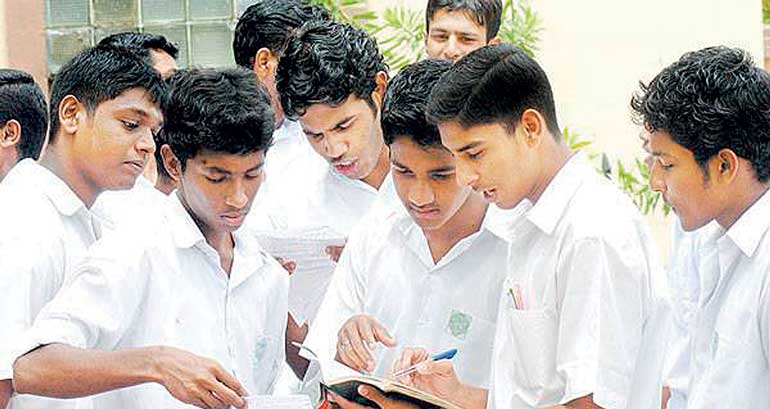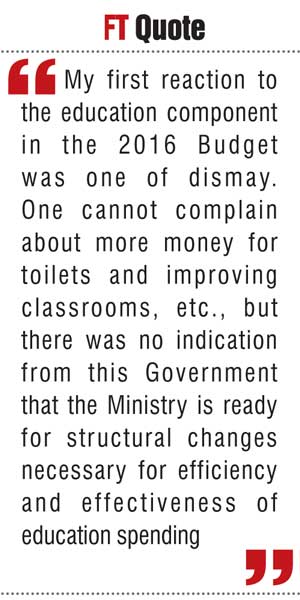Saturday Apr 19, 2025
Saturday Apr 19, 2025
Wednesday, 25 November 2015 00:00 - - {{hitsCtrl.values.hits}}

While the Government provides the infrastructure, the potential to transform education is in the hands of the National Institute of Education which is responsible for curricula and teacher training and development. The spotlight really should be on the performance of the NIE
The Budget is portrayed as a document for spelling out this tax change or that price change in the media, but the Budget is really an important policy document that spells out how money is allocated, why it is allocated and what is expected from the allocation.
My first reaction to the education component in the 2016 Budget was one of dismay. One cannot complain about more money for toilets and improving classrooms, etc., but there was no indication from this Government that the Ministry is ready for structural changes necessary for efficiency and effectiveness of education spending. 
The National Education Commission in Sri Lanka in its 2003 report said that the education system is characterised by three adverse features which are significant sources of inefficiency in public education. They were (i) Extreme politicisation of the system at all levels; (ii) Lack of coordination within the ministry and the agencies coming under the purview of the ministry and between the ministry and provincial authorities and (iii) Inefficiency, ineffectiveness and indifference of officials and principals, and lack of motivation among teachers.
The deep policy changes that are needed for reforms have been stressed by me and others on these columns and elsewhere but, by all indications, the Government is ready to go ahead with a threefold increase in the education budget to 90 billion, with what I call soft-touch policy changes.
In the real world, it is political realities not policy analysis that determine policies. Politicians are those best equipped to deal with political realities. As policy analysts it is our responsibility to see how we make the most out of the policy changes envisaged by them and comment on those in a constructive manner.
Policy has to fit politics
In public policy analysis, we learn that the problem may be well-defined and policy tools exist, but if those two do not align with politics, they don’t matter. When the problem, policy and politics align we call it a policy window.
The 100-day set of promises by the current President made many such policy windows possible and civil society and selected politicians used the opportunity to push some polices through the ‘window’ into legislation. However, more often than not, misalignment is the norm in Sri Lanka. When problem, policy and politics come close together in Sri Lanka, what we get is not alignment but fireworks.
In the Parliamentary tradition, a white paper is an authoritative report or guide that is presented by policymakers prior to presenting a Cabinet paper on an important topic. The objective is to inform and receive feedback from all stakeholders. With the Sri Lankan polity ready to pounce upon anything that looks like a policy, white papers have disappeared from the policy arena in Sri Lanka.
The UNP, in particular, has perhaps learned over the years to deal with a polity which is ready to mangle the messenger no matter the message. The UNP manifesto for the August 15th election and the Prime Minister’s policy statement of 5 November, perhaps reflects this cautious approach.

Light and not-so-light promises and policy statements
Among the policy changes proposed in the 2015 Manifesto of the UNP or the Economic Policy Statement (EPS) by the Prime Minister on 5 November, there are many ‘light’ initiatives and a few deep ones. In education, for example, there are seemingly light proposals which may turn out to be levers of change and two big proposals for a total nine explicit proposals. Namely:
“Initiate a program to provide facilities and incentives to schools without discrimination; Establish school oversight board; Provide sanitation facilities to schools; Limit the number of children in classrooms to 35; Introduce a new education act; Stop using teachers for non-academic duties; National examination date can be changed only with the approval of parliament; Establish a national e-library; Increase education allocation to 6% of the GDP.” [Translated from the Sinhala version of the UNP Manifesto, August 2015, p. 21].
The promise to increase the education allocation to 6% of the GDP is close to achievement with the 2016 allocation apparently being 5.4% of the GDP. (I say apparently because I have not been able to calculate the exact number from the data available). Bringing about a new Education Act would be another ‘deep’ change that the Government has been wise not to bring up in its first year.
The November EPS is brief on policy changes in education, but decreasing class size to 35 and providing facilities is prominent.
“We will encourage an education process that will go on for 13 years. Under a guideline established by Parliament, we plan to restrict the number of children in a classroom to 35. The schools will be provided facilities and access to the digital world that will bring the students together in their quest for knowledge” – Economic policy statement by PM, 5 November).
Overall, the EPS and UNP manifesto provides a series of light-touch policy changes which will not give much reason to be torn apart by an opposition. If well-executed, these policies can indeed lead to important changes in the education escort.
From light-touch policies to big changes
1. Small class sizes
Gradually reducing class size to 35 is a seemingly simple proposal to which nobody could object. However, if gradually implemented a small class size policy could be the lever that changes education.
A major problem of inequity in education the big schools get bigger phenomenon. At Royal College for example, there would be 20 or more parallel classes with over 50 students in each. Obviously parents send their children to these schools not for the education inside the classroom but other benefits such as belonging to a network of elites, etc.
No one policy tool could untangle this Web of work-arounds that have emerged over time for securing admission to these popular schools. However, when a simple rule about class size is enforced, parents, teachers and officials have to rethink their strategies. While chances of more work-arounds are possible, we can also expect some creative bottom-up solutions as well.
With the safety of children being a major concern, parent are now thinking of keeping children close to home and they have incentives to make the neighbourhood schools better. Increased funding for improvement of school infrastructures could push these tendencies further to improve neighbourhood schools.
2. Vouchers for school uniforms
Government expects to save Rs. 2 billion per year through a voucher system for distributing materials for school uniforms. This is different from typical voucher programs which are used to achieve ‘deep’ or systemic changes in education.
In a typical voucher program some or most of the funding for public institutions would be channelled through vouchers issued to students. Institutions have to compete for students. Simple in principle, but, as a World Bank analysis pointed out as far back 1996 and confirmed more recently, implementation can be fraught with problems.
What is interesting about the proposed voucher system is that it does not directly affect the school system or education, but, takes the purchasing and distribution out of the hands of bureaucrats.
The program could meet with hiccups in the initial year of two, where some families may find that they don’t have a vendor who accepts vouchers, etc., but, media and civil society need to report these events responsibly give the initiative a chance to succeed.
The biggest barrier to ensuring equity in school education is inefficiency in delivery. Every inefficiency is a leakage that reduces what is due to children. Every efficiency is a gain for the children. Replacing direct hand-outs with vouchers is a small step in efficiency that should be watched closely but supported.
3. Incentives
UNP’s Manifesto mentions incentives, but, we are yet to see any spelled out. This is a topic that deserves a separate analysis, along with the proposal to establish an oversight entity.
4. Oversight entity
An oversight entity is proposed, but, here too details are yet to emerge. According to the 13th Amendment, each Province is able to appoint is own Advisory board. Just as parliamentarians resisted the introduction of independent commission for long, Politicians at provincial level have no incentive to form these boards. In addition to setting up an oversight body at the Ministry of Education, it would advisable to encourage Provinces to set up their own. Linking some funds to oversight by Provincial Boards of Education would be a way to nudge the Provinces to action.
5. Performance evaluation
We get all excited about the budget every November, but, come following November nobody asks the “so what” question. It would be more effective if a performance evaluation mechanism is more clearly tied to the budget process.
In public policy we learn about at least three type of budgeting: traditional line-item budgeting, performance budgeting and zero-base budgeting. In line-item budgeting allocation for each line item is based on previous year’s allocation. Whether you increase or decrease and by how much being the main consideration. In zero-based budgeting, in theory at least, every allocation is set to zero and the allocation begins from a zero-base, so to speak. In a performance budget, each line is also broken down into performance units and allocations presented by each program and its expected performance. Without the performance component, the latter would be a program budget.
In Sri Lanka, the Budget is essentially a line-item budget listing how much is to be allocated to each expenditure head in each ministry. The Budget speech fleshes out the rationale and the performance expected in a broad sense, but, not in a manner conducive to follow-up evaluations.
In the 2016 Budget the total expenditure of 2,797 billion or (2.8 trillion) in rupees is listed under five or more categories where the distribution in billions (b) of rupees is as follows: Salaries and Wages including Provincial Councils (658 b); Other Goods and Services including Provincial Councils (313); Interest (520); Subsidies and Transfers (437) Public Investment in Education, Health, Infrastructure and Other (868b).
Education expenditures are embedded in the each of the line items in addition to the more explicit mention under the Public Investment category. The total expenditure for education is estimated as Rs. 90 billion, according to media reports. .
Anything resembling a program budget is found Annexure II in Budget document which details the expenditure proposals and the amounts allocated. Of the total 90 billion allocation to education 72% are listed under specific proposals l to improve school facilities (i.e. Teacher Training Programme, 1b; Teacher Development, 2b; Sanitary Facilities for Schools, 4b; Electricity for Schools, 2b; Upgrading Primary Schools, 10b; Providing Facilities to 1,000 Secondary Schools, 15b; Basic Facilities for 1360 Schools, 30b; Upgrading 25 Plantation Schools, 0.25b; Improving Science Education in Schools, 0.45b; Improving Dental Health Facilities, 0.25 b).
Since these programs are essentially facilities related any direct impact on educational quality has to come from elsewhere.
6. A high-performing National Institute of Education is key
While the Government provides the infrastructure, the potential to transform education is in the hands of the National Institute of Education which is responsible for curricula and teacher training and development. The spotlight really should be on the performance of the NIE.